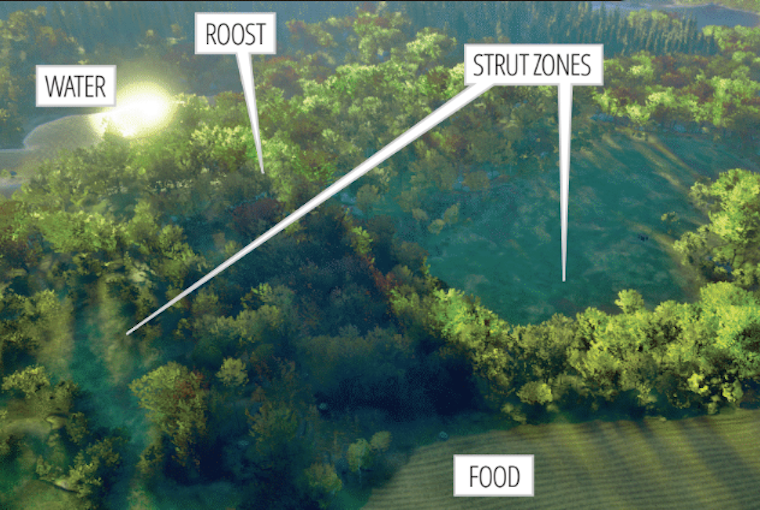
Find favourite turkey hideouts
by Scott McGuigan
All real estate isn’t created equal, as anyone trying to buy a house in Toronto or Vancouver can attest. It goes to the saying, “location, location, location.”
It’s the same when hunting turkeys, putting yourself in a good location is a surefire way to increase your success. In addition to location, what drives wild turkey behaviour, and how do we use it to find them? In the spring, they are all about safety, food, and the urge to breed. Let’s use that knowledge to find some turkeys
The turkey roost
We’ve all heard how important it is to get a goodnight’s sleep, free from stress. I imagine the same holds true for turkeys. In fact, the absolute first thing to locate on a new property are the turkeys’ safe zones: their roosting (sleeping) areas.
Think about roosts like medieval castles, built on the side of a cliff, walled and fortified, and guarding a port or waterway. Castles have all the essentials for human survival, and turkeys are looking for the same sort of shelter, so some areas are more appealing to them than others.
Big expansive hardwoods like maples or oaks are turkey favourites. Find a grove of them, and you’re really onto something. Look for clusters of tall, mature trees that have vast, expansive, parallel limbs. The bigger the limbs the better, as they make the birds feel more secure when they shut their eyes.
Many trees will host a bird at some point over the season, but good roosting trees will hold birds all the time. I’ve heard lots of stories of “un-killable” birds that live in a certain tree. The tale is that they live on, year after year, whereas the truth is more likely that the tree is so appealing, it’s quickly taken over by a new bird when the previous tenant is dispatched.
Some roost trees will hold a bevy of birds, but as a hunter, that means you’ll have competition from live hens. Those trees are a great starting place, but unfortunately, eight turkeys up a tree doesn’t automatically mean a successful hunt. The best time to go into the woods and find good roost trees is in the winter, when there isn’t any foliage to obscure your view.
Follow the food
Safety may be priority one for turkeys, but right behind that is food. Amorous gobblers may be willing to operate on an empty belly, but hens are going to follow their regular feeding patterns, and where there are hens, males are sure to be strutting around, too.
Turkeys can eat lots of things, but at the top of the list are grains and insects. Pastures are a great spot to look for turkeys because the undersides of cow patties are usually littered with high-protein insects; the patties seem to concentrate them. So, if there is pasture around your turkey haunts, you can be sure the birds will visit at some point.
When you’re setting up to hunt a food source, the key is identifying the active food source. Sometimes birds will roost right along the edge they are also more than happy to walk a ways to get to those fields, so don’t be disheartened if birds don’t show up in the first few minutes of legal light.
Only good old-fashioned scouting is going to tell you where the birds are doing most of their feeding, and checking fields is a great starting point. If you find one with a visible amount of grain left in it, key in on it first, and keep an eye out for turkey tracks.
Water works
Turkeys love to roost by water. Be it a river, lake, or pooled low spot, water just attracts birds. If your turkey hunting property has water around it, I’d bet that birds will be roosting nearby.
Turkeys also like knobs and ridges. My theory for this is that the higher ground gives birds as lightly better lookout, and the trees on that elevated land out-compete surrounding trees for sunlight, growing into large, favourable roost trees.
Turkey strut zones
Strut zones are places you may want to zero in on. The strut zone is a pretty broad term, because it refers to any place a bird does a significant amount of its strutting. In this scenario turkeys want to be visible. Gobblers aren’t going to tuck themselves away in thick cover to do this, they are going to head to open areas where they can be seen.
Oftentimes in Ontario that will be an agricultural field. But, openings in the woods are great spots to look, too. For example, power line openings, old farm pathways — any clear-cut situation where jakes and toms can be more visible.
Even deep in the bush, open areas are likely to be attractive, particularly if there is a ridge. If you hunt the same property year after year, you’ll see patterns develop. Scouting will help you too, and remember, tracks don’t lie. Put yourself in a position to get lucky, and in time, it won’t feel like luck at all.
Uphill battle
Common turkey advice warns against trying to call a turkey downhill, and I don’t have any spurs on my necklace from such a set-up. The problem is gobblers will come to the edge of the high ground and search for the hen below. If you have a decoy out, this could work. However, it’s also likely the gobbler will be inclined to stay and strut on that favourable high ground, well out of range.
Setting up slightly below a ridge but within range of the peak is a good tactic. A gobbler will often hang up on decoys, but if it can’t see what’s doing all the calling, odds are he will come to the edge to check it out.
That’s your opportunity. Keep your head on a swivel, as it can all happen (or fall apart) very quickly
Stage the perfect ambush
by Alan Davy
Long beards are genetically programmed to hang up on their way to your call. That’s how their beards get long. So, don’t give them any more excuses to delay. Choose a location that keeps them coming right into your set-up.
Sure, it’s nice to sit where you can watch a tom coming in for hundreds of yards, but chances are good he’ll hang up while still out of range. That’s because he can see where the call is coming from, and yet he can’t see a hen.Even if you use decoys, he may still hang up, because the hen would typically come the rest of the way to him. But, if he doesn’t have a visual on the call site, he’ll keep moving until he does, and then, he will be in range.
Over the hill
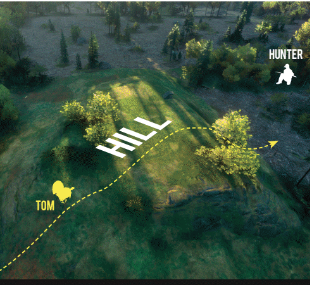
If a tom is gobbling on the other side of a hill or ridge, be it field or forest, sneak to within 30 yards of the crest, out of his line of sight, and set up there to call to him. He’ll have to come over the crest to investigate your call and he’ll be in range when he does.
Bench him
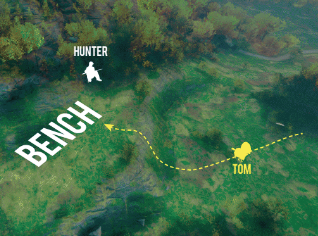
Set up on a small, level plateau or bench on the side of hill. Being up high, your call will reach out well and it’s also the kind of place toms like to go to strut and display. But most importantly, that tom won’t see the set-up until he walks up onto the bench and into range.
Dish it out
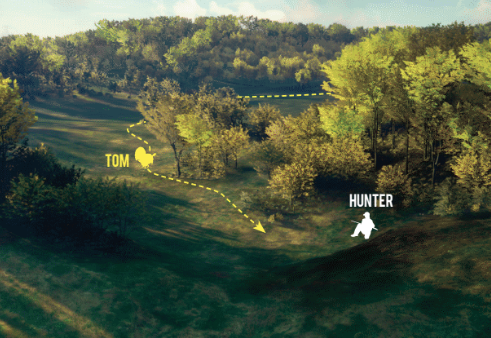
Call from a small depression or dish in the landscape, a little deeper than the top of your head when you’re sitting down. I’m not talking about a hole here, just a saucer-like depression or swale. Be sure of a safe background with this set-up as with all other backrests. Listen for his footsteps in case he stops gobbling to sneak in and be ready to shoot when you see his crinkly red, white, and bluehead appear over the crest.
Edge away

Field toms are tough to call to the edge of the field because they can see that there isn’t a hen in view. So, move back 20 or 30 yards into the woods at a point that’s not real brushy, but still provides some concealment. If you can get under a field tom’s feathers with your calling, he’ll come to the edge (and into range) for a look into the woods.
Around the bend

Toms will travel along tractor trails and logging roads to get to your call. So, set up near a bend in the trail that he can’t see around. This will keep him coming around the corner, where he’ll be in range as he steps into view.
Blind him
If your hunting terrain doesn’t offer so much as a wrinkle between you and a prospective tom, then a pop-up blind is the way to go. Wild turkeys are generally not alarmed by blinds as long as they don’t see or hear you moving inside. Set them up under full darkness, or even better, a day or two before you hunt.
Wear black clothes and sit back from the window to be less visible inside. Open the windows on the side you expect a tom to come in from and leave the other sides closed, otherwise, a tom will see your silhouette. But, be sure to undo the zippers or ties for all the windows so you can quickly and quietly open them if a tom does appear from an unexpected direction.
Whether you tag a tom or not often depends on where you sit down to call. So when you hear that tom gobbling, take the time to look for the deadliest set-up.
The right tree
Pick a tree or stump at least as wide as your shoulders. In full camo, your outline will be obscured by the tree, thanks to a turkey’s monocular vision. As long as you don’t move, you’ll look like you’re pasted flat onto the tree.Don’t call from thick bushes, because hens only go there to hide from predators or to nest, and they don’t call from their nesting locations. Also, toms want safe, easy walking when they investigate a call.
Make birds hunt for you
by Yannick Loranger
When my calls, camo, and shotguns came out for last spring’s turkey hunt, the decoys stayed in the basement. Though decoys are considered by many to be a vital tool for turkey hunting, I have come to rely less and less on them.
Sure, in some scenarios, a well-placed decoy or decoys can definitely lead to success, but by focusing more on a turkey’s acute sense of hearing, and less on his sight, hunters can avoid those catastrophic decoying mistakes that leave pressured toms hung up out of range.
Out of sight, on his mind
Curiosity may have killed the cat, but it’s been the demise of many toms as well. Decoys work when a turkey is expecting to see other turkeys. A hunter calling from a ground blind in an open field would be foolish not to use a decoy, but there are lots of scenarios where the hen would not be visible until the tom is in close range.
When hunting without a decoy, you are making a turkey search out sound and only sound. It’s paramount, when using this strategy, to set up where you are sure a bird can’t spot you until he is within range. Generally, setting up at least 50 yards from a field edge is wise.
I’ve made the mistake of setting up in the woods too close to the edge, and while I had a better visual of the toms, more often than not they hung up just out of range, expecting to spot the hen they’d heard calling just moments before.
Calling
When it comes to calling in birds with this decoy-less technique, less is more. Assume when you hear a gobble that the turkey knows exactly where you are. Calling excessively will either draw attention to you, or simulate an excited hen, which would naturally make her way to the tom.
Remember, the whole idea behind not using a decoy is to avoid any visual red flags for an incoming turkey.If you must call to a nearby bird, try to do so while he’s out of sight, like in a ditch or behind a large tree. I’ll also often use a mouth call and turn my head away from the bird. I’ll let out a few soft yelps to make myself sound farther than I am, in hopes of directing the bird’s attention away from my actual location.
For the last few years, I’ve started most of my calling sequences with a purr. It seems particularly effective at bringing hens in, and more often than not when you call in hens, the toms follow. My preferred calling sequence is a purr followed by five to 10 yelps
Patience
If you’re used to having a clear view of turkeys coming in, this technique may be excruciating for you. If they can’t see you, you likely can’t see them. And when a bird does appear, he is already well within shotgun range. If you have the patience, these up close and personal encounters are heart-stopping. This spring, consider lightening your turkey backpack and setting yourself up for success.
Your number-one enemy when hunting without decoys is yourself, especially when birds are being quiet. Fight the urge to peek at what’s going on out of sight. Too often, I’ve wasted a long sit by spooking a bird by looking around.
Originally published in the April 2019 issue of Ontario OUT of DOORS magazine


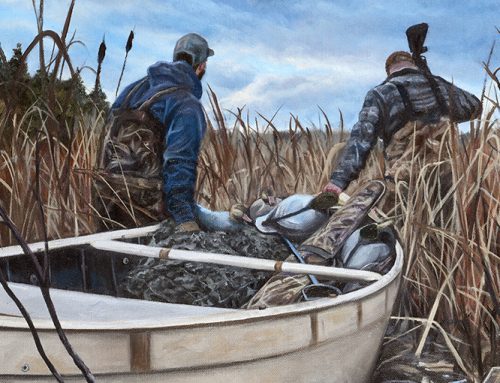
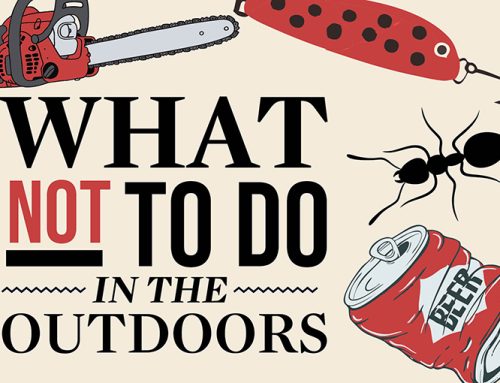
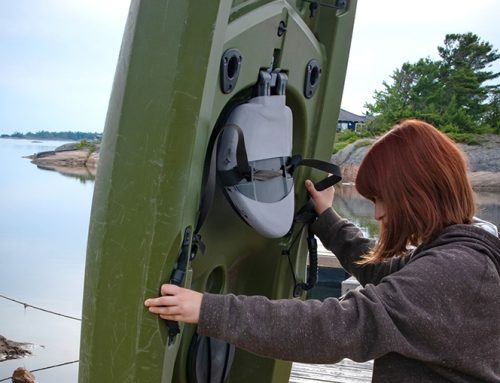

Leave A Comment